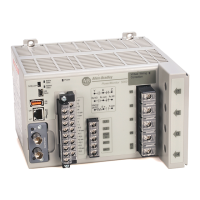502 Rockwell Automation Publication 1426-UM001J-EN-P - August 2019
Glossary
Induction Motor An alternating current motor in which the primary winding (usually the stator) is
connected to the power source and induces a current into a secondary (usually
the rotor).
Inductor A device consisting of one or more windings with or without a magnetic core.
Motors are largely inductive.
Influence Quantity Any external quantity, such as temperature or electro-magnetic interference, that
can affect the accuracy of a measured parameter.
Initiator Pulses Electrical impulses that are generated by pulse-initiator mechanisms installed in
utility revenue meters. Each pulse indicates the consumption of a specific number
of watts. These pulses can be used to measure energy consumption and demand.
Interharmonics Frequencies between the harmonics of the power frequency voltage and current,
which are not an integer of the fundamental. They can appear as discrete
frequencies or as a wide-band spectrum.
Interharmonic Group The rms value that is obtained by combining the rms value of the measured
interharmonic values between two adjacent harmonic frequencies. See EN
61000-4-7 for more details.
K-factor A measure that indicates heating in a power transformer due to harmonics in the
power signal. These harmonics cause additional heating due to increased core
losses that occur at higher frequencies.
Lagging Current The current flowing in an AC circuit that is mostly inductive. If a circuit contains
only inductance, the current lags the applied voltage by 90°. Lagging current
means lagging power.
Leading Current The current flowing in a circuit that is mostly capacitive. If a circuit contains only
capacitance, the current leads the applied voltage by 90°. Leading current means
leading power factor.
Load Any device or circuit consuming power in an electrical system.
Load Shedding The removal of load from the line to limit load and control demand level.
Load Restoring The energizing of loads that were previously removed from the line to limit load
and control demand level.
Mains Signaling Voltage A burst of signals that are usually applied to a power circuit at an interharmonic
frequency. Used to control remotely industrial equipment, revenue meters, and
other devices.
Measurement Uncertainty The range of possible error in a measurement as a percent of the ideal value.
Neutral The conductor that is chosen as the return path for the current from the load to
the source. Neutral is also a voltage reference point in a power system.

